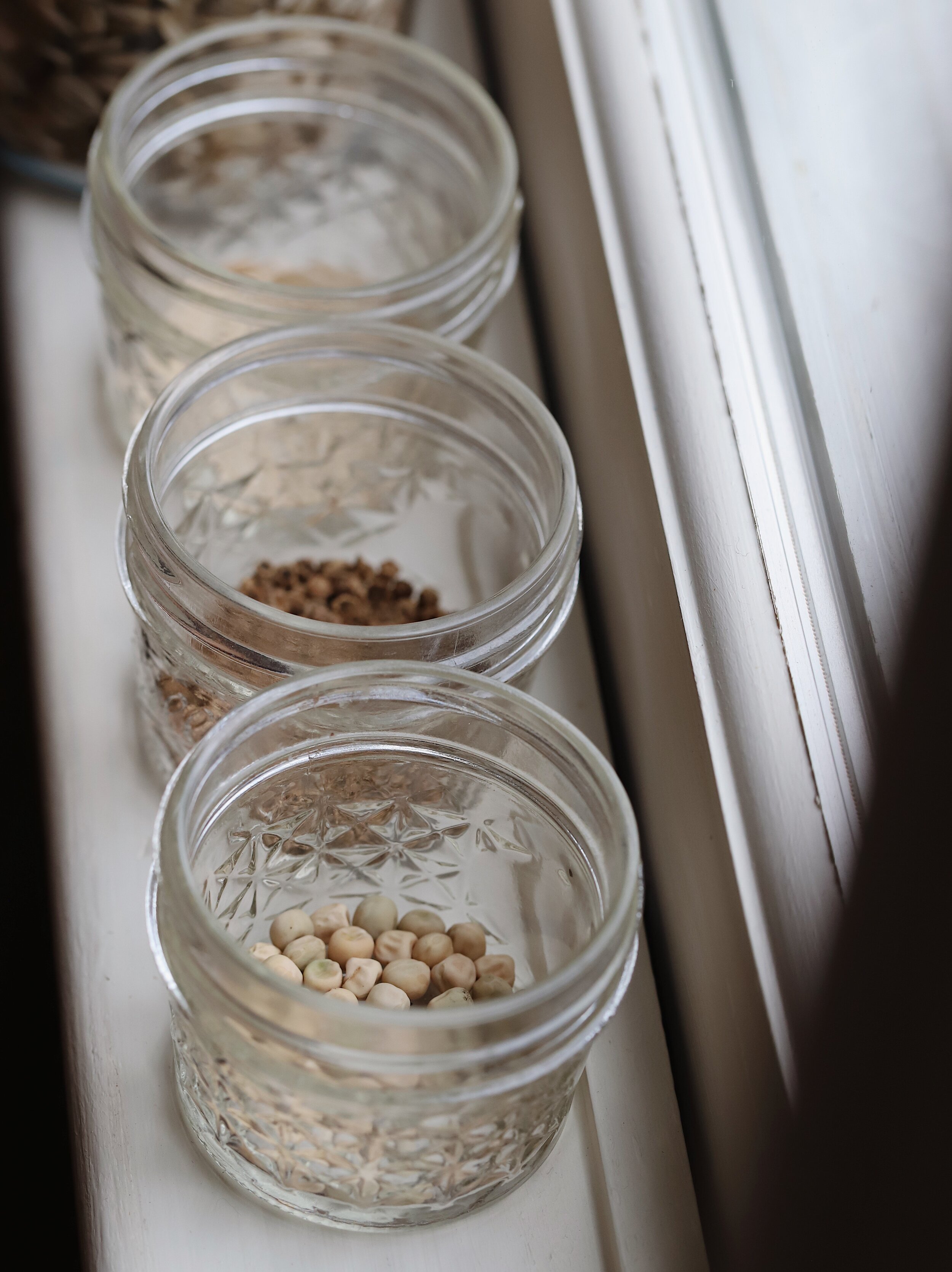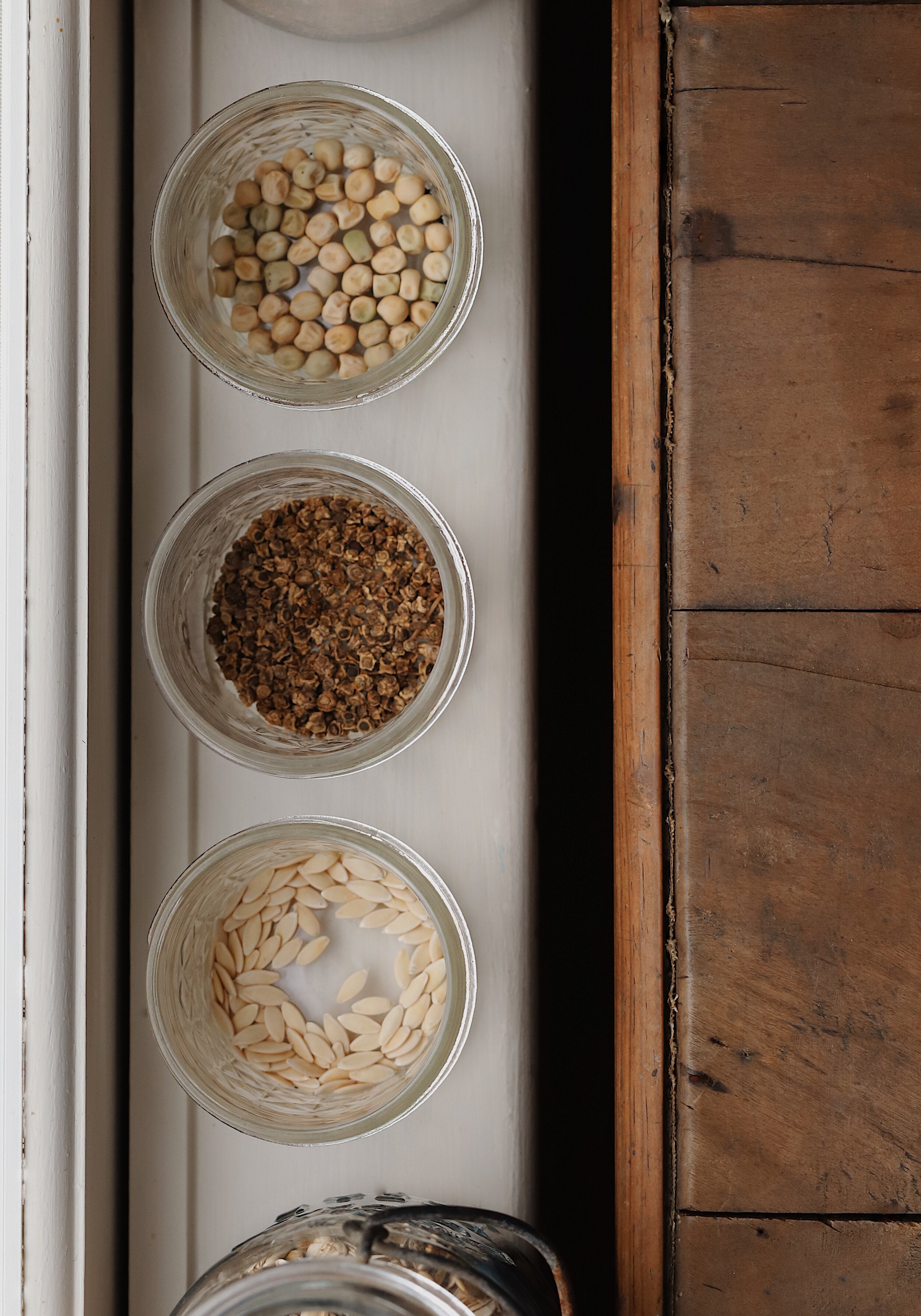Tips for Saving Seeds
Only a few generations ago, collecting and saving seeds was a common part of gardening and growing food. Children harvested seeds along with their parents, grandparents, aunts, and neighbors and traded them locally as part of a seasonal tradition. Seeds were selected to be well-suited to local environments and passing down heirloom varieties from generation to generation was the norm.
Times have changed, of course, and now most seeds come from just a few large corporations that serve the interests of large scale agriculture. What this means is that seeds are bred to support the needs of BIG farming operations, with little regard for genetic diversity, flavor, and all the other nuanced qualities a home gardener has the patience and time to notice.
In recent years, small seed companies and individual gardeners have begun to question this centralized model of seed production and saving seeds has, all the while, begun to make a comeback. I save seeds to feel more connected to my garden - it forces me to pay attention in a way that feels exciting and therapeutic - but other gardeners do it for a variety of different reasons. Here are just a few.
SAVING SEEDS SAVES MONEY. Buying seeds isn’t all that expensive, compared to buying starts, but the cost of planting your garden can add up fast, especially if you have a large plot to sow.
SAVING SEEDS PRESERVES GENETIC DIVERSITY (AND YOUR FAVORITE VARIETIES). The commercial seed industry is dominated by just a few big companies that focus on a small handful of crop varieties. Saving seeds has become essential to preserving genetic diversity. It’s a great way to ensure you’ll have access to the varieties you’ve come to know and love. You never know when a seed catalog might discontinue a favorite heart-shaped tomato or perfect pickling cucumber in order to make and market new varieties. Your only guarantee for having access to your favorite varieties is to save their seeds yourself.
SAVING SEEDS HELPS GARDENERS CONNECT WITH THEIR ANCESTORS. Saving seeds ensures that future generations can enjoy the same varieties of tomatoes and great-tasting beans our great-grandparents grew. To save seeds is to preserve history and culture; if not for the gardeners who devote themselves to growing and saving seeds, heirloom varieties would probably go extinct.
SAVING SEEDS HELPS POLLINATORS. Pollinators are vital to heathy, stable food supplies and the varied and nutritious diets we need and enjoy. Pollinators are also in decline. Allowing crops to go to flower and seed provides an invaluable food source for bees, butterflies, and beetles.
SAVING SEEDS PROMOTES SELF-RELIANCE. In times of trouble, or when seeds are hard to find, it’s reassuring to know you can fall back on your own personal stash. Saving seeds allows you to have greater control of your food supply.
SAVING SEEDS ADAPTS PLANTS TO YOUR GARDEN AND IMPROVES THE QUALITY OF CROPS. To save seeds is to participate in the process of evolution. When you save seeds from your healthiest, tastiest, most robust plants, and continue to do so season after season, you gradually make improvements to the quality of those seeds.
tips for saving seeds
Saving seeds isn’t hard. Once you know the basics, it’s easy to save them from crops like tomatoes, lettuce, and beans. Saving seeds from plants like carrots and squash is a bit more challenging, but nothing a little commitment and determination can’t overcome. Before diving in, it helps to understand different types of seeds, as well as best practices for harvesting, drying, and storing them. Here are a few tips to help you get started.
GROW OPEN-POLLINATED SEEDS.
Make sure you save seeds from open-pollinated varieties and not from so-called F1 hybrids. Open-pollinated seeds are the kind that, when properly isolated from other varieties of the same plant species, produce seeds that are genetically “true to type,” meaning they’ll look similar to their parents. Heirloom seeds are a type of open-pollinated seed that have a history of being passed down within a family or community. An heirloom variety must be open-pollinated, but not all open-pollinated seeds are heirlooms.
If open-pollinated varieties are allowed to cross with other varieties within the same species, the resulting seed will be a hybrid. This can happen naturally or artificially. An F1 hybrid is the first-generation offspring from a deliberate cross of two different parent plants. These plants are bred to produce desirable traits, such as disease resistance, outstanding vigor, and high productivity. Although the first generation of plants produced from F1 seeds will produce these traits, the second generation will not be true to type. What that means is that if you plant the seeds of F1 hybrid plants, you can’t be sure what qualities they will have.
START WITH SELF-POLLINATING PLANTS.
Seeds are the product of pollination. Some plants self-pollinate, meaning the plant can fertilize itself. Other plants cross-pollinate and need pollen from another plant in order to set seed. The easiest way to save pure seeds—that is, to ensure seeds that grow true to type—is to collect them from plants that self-pollinate. Examples of self-pollinating plants include beans, lettuce, peas, peppers, and tomatoes. Broccoli, corn, cucumbers, leeks, melons, onions, radishes, and squash are common cross-pollinating crops.
START WITH ANNUALS INSTEAD OF BIENNIALS.
It’s easier to collect seeds from annual crops than biennial ones because annual crops go to seed the same season they’re sown. Biennial crops like carrots and beets, on the other hand, have to be kept alive and in good condition through the winter in order to produce flowers or seeds during their second year of growth.
GROW A SINGLE VARIETY OF CROSS-POLLINATING CROPS.
Seed saving gets a little complicated with cross-pollinating crops, such as corn, cucum- bers, and squashes. To save pure seed, you need to prevent cross-pollination between two different varieties of the same species. Seed savers use various strategies to isolate varieties, including distance, caging, and bagging, but the easiest way to prevent cross-pollination is to plant only one variety of these species at a time. Then you can watch insects pollinate flowers without worrying they’ll sully the purity of each crop’s seeds. Can you imagine herding a bee to the right flower? Sounds exhausting!
SAVE SEEDS FROM THE BEST PLANTS.
Saving seeds allows you to choose which plants get to reproduce. Observe your plants well, taste their produce, and save the seeds from the best performers. If you want tomatoes that ripen early, save seeds from the first fruits that ripen each year. If you want disease-resistant
squash, save seeds from the fruits that matured unscathed. Eventually, your seeds will have the traits you most desire, while being well adapted to growing in your particular climate.
TAKE EXTRA-GOOD CARE OF CROPS YOU’RE GROWING FOR SEED.
If you know you’re growing a plant specifically for its seed, take care of it as well as—if not better than—plants you’re growing to eat. After all, it will become the blueprint for future crops. Start with good-quality seeds and provide them with rich soil, adequate water, and protection from pests and disease.
HARVEST SEEDS AT THE RIGHT TIME.
Seeds are ready to save when they are fully ma- ture, which does not always coincide with when a plant or fruit is ready to eat. It’s important to get the timing right, as seeds picked too soon won’t germinate. With the exception of toma- toes, seeds should be harvested as late in the season as possible.
CLEAN SEEDS PROPERLY.
Seeds must be cleaned properly to prepare them for storage. The methods for cleaning dry seeds are different than those for cleaning wet seeds. Dry seeds, such as those for lettuce and radishes, are usually mixed with chaff—pieces of the flower head, stem, and leaves. You can separate the seed from the chaff by hand or, if you have a lot of seeds, you can speed up your work by using mesh of the appropriate size. Winnowing is another option and involves placing seeds in a large flat basket and repeatedly tossing them into the air. If there’s a light breeze, the chaff will blow away while the heavier seeds fall back into the basket. If there’s no natural breeze when you need one, you can create an artificial one by using a fan.
Cleaning wet seeds, such as those for squash and tomatoes, is a bit messier and—in the case of tomatoes—more involved. To clean wet seeds from the squash family, simply place the seeds in a colander and rinse them with water until the wet, sticky film washes away. (See the tutorial opposite for how to clean tomato seeds.)
DRY SEEDS PROPERLY.
Cleaned seeds should be dried in an airy place at room temperature. To speed up the drying process, place a small fan on low speed nearby so that it blows gently on the seeds. To test whether a seed is completely dry, place one end between your teeth and bend the other end with your fingers. A dried seed will break in half. For larger seeds like beans, place one on a hard surface and hit it with a hammer. If it’s dry, it’ll shatter into pieces.
STORE SEEDS PROPERLY.
To preserve their viability, keep seeds away from heat, humidity, sunlight, and hungry rodents. Put them in sealed paper envelopes, labeled with their crop and variety name, as well the month, day, and year they were collected. Place the envelopes in an airtight container that will keep out moisture (and rodents!), such as a glass jar or plastic storage container. For added protection against humidity, place milk powder or silica gel at the bottom of the container. Keep the con- tainer of seeds in a cool, dry, dark place, such as a basement or closet. A refrigerator is a safe place to keep seeds, too—just be sure to store them in airtight containers. Allow the refrigerated container to warm to room temperature before opening it to prevent moisture from condensing on the seed packets.
In the photos to the left, you can see I saved seeds from sunflowers, cucumbers, and peas. The beets were given to me as a gift, as I’ve yet to save seeds from biennial plants. I also saved flower petals from roses and calendula, which I hope to use in some of the recipes from the natural wellness and bath and body sections of my book (I’m thinking: boo boo balm and herbal bath salts, but rose water is a favorite too!). At any rate, seed saving doesn’t have to be involved or complicated. Even saving seeds from just a few fruits and veggies that stood out as special or unique can help you become more observant and connected to your garden. If you do it for no other reason, do it for the joy of it! Always.






